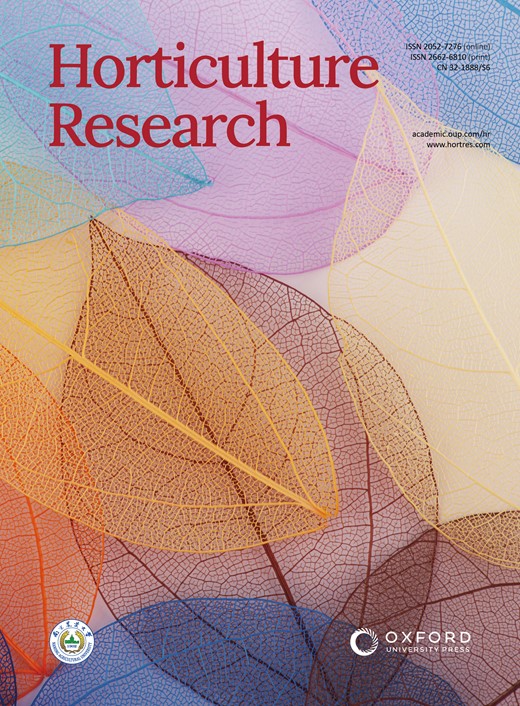十倍体蕺菜基因组组装为蕺菜的进化和生物碱的生物合成提供了启示
IF 8.5
1区 农林科学
Q1 Agricultural and Biological Sciences
引用次数: 0
摘要
虫草(Houttuynia cordata Thunb.)在中国俗称 "玉星草",以其特有的腥味而闻名,在亚洲许多地区被广泛视为重要的草本植物和蔬菜。然而,由于缺乏有关虫草的基因组信息,限制了对其种群结构、遗传多样性和药用化合物生物合成的了解。在这里,我们利用单分子测序、Illumina成对端测序和染色体构象捕获技术构建了首个染色体尺度的十倍体虫草参考基因组。根据Hi-C分析,该基因组的组装大小为2.63 Gb,共有1 348个等位基因,等位基因N50为21.94 Mb,并进一步聚类和排序为88个假染色体。基因组进化分析结果表明,H. citrina在大约1700万年前经历了一次全基因组复制(WGD)事件,在330万年前又发生了一次WGD事件,这可能是导致多拷贝同源基因高丰度的主要因素。在这里,通过对五个不同组织的转录组测序,发现了一些关键基因家族的显著扩增和不同的表达模式,如对异喹啉和吲哚生物碱的生物合成至关重要的 L-氨基酸/色氨酸脱羧酶和严格苷合成酶,同时还发现了对根系发育至关重要的 TTM3 等基因。该研究构建了第一个十倍体药用植物基因组,揭示了虫草的基因组进化和多倍体化事件。本文章由计算机程序翻译,如有差异,请以英文原文为准。
A Genome Assembly of decaploid Houttuynia cordata Provides Insights into the evolution of Houttuynia and the biosynthesis of alkaloids
Houttuynia cordata Thunb., commonly known as yuxingcao in China, is known for its characteristic fishy smell and is widely recognized as an important herb and vegetable in many parts of Asia. However, the lack of genomic information on H. cordata limits the understanding of its population structure, genetic diversity and biosynthesis of medicinal compounds. Here, we used single-molecule sequencing, Illumina paired-end sequencing and chromosome conformation capture technology to construct the first chromosome-scale decaploid H. cordata reference genome. The genome assembly was 2.63 Gb in size, with 1,348 contigs and a contig N50 of 21.94 Mb further clustered and ordered into 88 pseudochromosomes based on Hi-C analysis. The results of genome evolution analysis showed that H. citrina underwent a whole-genome duplication (WGD) event approximately 17 million years ago, and an additional WGD event occurred 3.3 million years ago, which may be the main factor leading to the high abundance of multiple copies of orthologous genes. Here, transcriptome sequencing across five different tissues revealed significant expansion and distinct expression patterns of key gene families, such as L-amino acid/L-tryptophan decarboxylase and strictosidine synthase, which are essential for the biosynthesis of isoquinoline and indole alkaloids, along with the identification of genes such as TTM3, which is critical for root development. This study constructed the first decaploid medicinal plant genome and revealed the genome evolution and polyploidization events of H. cordata.
求助全文
通过发布文献求助,成功后即可免费获取论文全文。
去求助
来源期刊

Horticulture Research
Biochemistry, Genetics and Molecular Biology-Biochemistry
CiteScore
11.20
自引率
6.90%
发文量
367
审稿时长
20 weeks
期刊介绍:
Horticulture Research, an open access journal affiliated with Nanjing Agricultural University, has achieved the prestigious ranking of number one in the Horticulture category of the Journal Citation Reports ™ from Clarivate, 2022. As a leading publication in the field, the journal is dedicated to disseminating original research articles, comprehensive reviews, insightful perspectives, thought-provoking comments, and valuable correspondence articles and letters to the editor. Its scope encompasses all vital aspects of horticultural plants and disciplines, such as biotechnology, breeding, cellular and molecular biology, evolution, genetics, inter-species interactions, physiology, and the origination and domestication of crops.
 求助内容:
求助内容: 应助结果提醒方式:
应助结果提醒方式:


